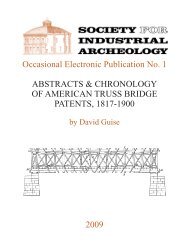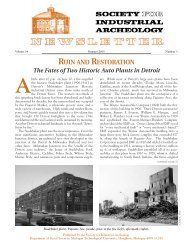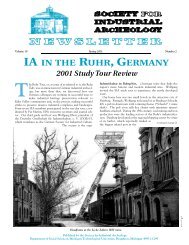birmingham, “pittsburgh of the south,” - Society for Industrial ...
birmingham, “pittsburgh of the south,” - Society for Industrial ...
birmingham, “pittsburgh of the south,” - Society for Industrial ...
You also want an ePaper? Increase the reach of your titles
YUMPU automatically turns print PDFs into web optimized ePapers that Google loves.
sample; based on <strong>the</strong> results, manganese, silicone, and carbon are<br />
added to meet product specifications. Chrome, vanadium, or titanium<br />
may also be added. The steel is <strong>the</strong>n poured into a continuous<br />
billet caster. The billets are cut to <strong>the</strong> desired length and<br />
stored in <strong>the</strong> billet yard. In <strong>the</strong> rolling mill, <strong>the</strong>y are heated to<br />
2200° F. in a pusher-type reheat furnace, <strong>the</strong>n passed through<br />
roughing, intermediate, and finishing stands. The rolled products<br />
are cut and delivered onto an automatic cooling bed. The finished<br />
product—angles <strong>the</strong> day <strong>of</strong> our visit—is straightened, cut, stacked,<br />
and bundled <strong>for</strong> shipping. A brand-new Danieli stacker, controlled<br />
remotely from a pulpit, per<strong>for</strong>med balletic feats <strong>of</strong> movement<br />
as two steelworkers skillfully manipulated <strong>the</strong> controls. At<br />
<strong>the</strong> conclusion <strong>of</strong> our tour, SMI employees greeted us with cold<br />
drinks and cookies, and passed out padded picnic coolers bearing<br />
<strong>the</strong> company logo. Dinner (that night on our own) was followed<br />
by <strong>the</strong> traditional “show-and-tell<strong>”</strong> featuring highlights <strong>of</strong> <strong>the</strong> 2000<br />
SIA Annual Conference in Duluth.<br />
In contrast with <strong>the</strong> intensity <strong>of</strong> Thursday and Friday, Saturday’s<br />
pace was more leisurely. The buses joined <strong>the</strong> caravan <strong>of</strong> Crimson<br />
Tide supporters headed west on I-59 to <strong>the</strong> big game, exiting short<br />
<strong>of</strong> Tuscaloosa to head sou<strong>the</strong>ast into <strong>the</strong> Alabama countryside. It<br />
was a brilliant autumn morning and a distinct treat to disembark<br />
at Tannehill Ironworks Historical State Park, our first stop <strong>of</strong><br />
<strong>the</strong> day. The park is home to <strong>the</strong> Iron & Steel Museum <strong>of</strong><br />
Alabama, where Alabama Secretary <strong>of</strong> State James R. Bennett,<br />
author <strong>of</strong> <strong>the</strong> newly published Tannehill and <strong>the</strong> Growth <strong>of</strong> <strong>the</strong><br />
Alabama Iron Industry, briefly greeted us, <strong>the</strong>n signed books as we<br />
wandered among <strong>the</strong> displays. We <strong>the</strong>n trooped to <strong>the</strong> furnace<br />
area, where portions <strong>of</strong> three slave-built Civil War-era charcoal<br />
iron furnaces have been restored. Jack R. Bergstresser [SIA], pr<strong>of</strong>essor<br />
<strong>of</strong> archeology at <strong>the</strong> University <strong>of</strong> Alabama-Birmingham,<br />
recounted <strong>the</strong> history <strong>of</strong> <strong>the</strong> furnaces, which used local brown ore<br />
to provide pig iron <strong>for</strong> <strong>the</strong> Confederate war ef<strong>for</strong>t, and described<br />
<strong>the</strong> archeological work (some <strong>of</strong> it botched) that has been done at<br />
<strong>the</strong> site. At <strong>the</strong> height <strong>of</strong> production, Tannehill turned out 20<br />
tons <strong>of</strong> iron each day. Then, on March 31, 1865, three<br />
companies <strong>of</strong> <strong>the</strong> Eighth Iowa Cavalry swept through<br />
<strong>the</strong> area, reducing <strong>the</strong> industrial site and <strong>the</strong> cabins <strong>of</strong><br />
600 slave laborers to ruins.<br />
Leaving Tannehill, we headed back along Red<br />
Mountain toward Birmingham and <strong>the</strong> Cahaba<br />
Pumping Station. Cahaba, <strong>the</strong> main source <strong>of</strong> water<br />
<strong>for</strong> <strong>the</strong> Birmingham area <strong>for</strong> over a century, combines a<br />
modern pumping station with a learning center with<br />
displays explaining <strong>the</strong> process and history <strong>of</strong><br />
Birmingham’s water supply. The site’s historic buildings<br />
house early tools, equipment, photographs, and<br />
<strong>Society</strong> <strong>for</strong> <strong>Industrial</strong> Archeology Newsletter, Vol.28, No. 4, Winter 1999<br />
o<strong>the</strong>r artifacts, including two Brownhoist Co. cranes designed to<br />
travel on a circular track. We were free to wander <strong>the</strong> site and<br />
view old and new equipment at leisure. Many enjoyed box lunches<br />
picnic-style, on <strong>the</strong> grass.<br />
From Cahaba, we returned to downtown Birmingham <strong>for</strong> a visit<br />
to <strong>the</strong> gaudy and glorious Alabama Theatre. Paramount Studios<br />
built <strong>the</strong> “Showplace <strong>of</strong> <strong>the</strong> South<strong>”</strong>—an eclectic Romanesque/<br />
Grecian/Mediterranean confection—in 1927 at a cost <strong>of</strong> $1.5 million.<br />
For 54 years it was <strong>the</strong> prime entertainment center <strong>of</strong><br />
Birmingham, showing first-run movies and hosting a variety <strong>of</strong> live<br />
entertainment to <strong>the</strong> accompaniment <strong>of</strong> <strong>the</strong> Mighty Wurlitzer pipe<br />
organ. Rescued and restored by Birmingham Landmarks, Inc., <strong>the</strong><br />
Alabama today hosts touring shows, meetings, weddings, and local<br />
arts groups, as well as occasional classic films. We toured <strong>the</strong> ornate<br />
lobbies and lounges and were free to wander through <strong>the</strong> back <strong>of</strong> <strong>the</strong><br />
house, into <strong>the</strong> dressing rooms and projection booth. Cecil<br />
Whitmire, president <strong>of</strong> Birmingham Landmarks, <strong>the</strong>n delighted <strong>the</strong><br />
group with a short concert demonstrating <strong>the</strong> Mighty Wurlitzer’s<br />
great range. After one particularly ornamental flourish, <strong>the</strong> irrepressible<br />
Colin Batchelor, only 10 years old but already an SIA<br />
hand, made a surprise cameo appearance, jumping out from behind<br />
<strong>the</strong> velvet curtain and bringing <strong>the</strong> house down with laughter.<br />
The day’s last stop was <strong>the</strong> Barber Vintage Motorsports<br />
Museum, home <strong>of</strong> <strong>the</strong> largest private collection <strong>of</strong> motorcycles in<br />
<strong>the</strong> world. On display are classic bikes as well as championship<br />
racing cycles and cars. Tour goers also visited <strong>the</strong> facility where<br />
<strong>the</strong> Barber staff restores and maintains <strong>the</strong>se vintage vehicles. A<br />
few <strong>of</strong> us, <strong>for</strong>egoing <strong>the</strong> motorcycle museum, instead made our way<br />
on foot to <strong>the</strong> Birmingham Civil Rights Institute, opened in<br />
1992. We walked first through Kelly Ingram Park with its numerous<br />
sculptures, some emotionally gripping, treating <strong>the</strong>mes <strong>of</strong> <strong>the</strong><br />
civil rights struggle in which Birmingham played a central role.<br />
Opposite <strong>the</strong> northwest corner <strong>of</strong> <strong>the</strong> park is <strong>the</strong> Sixteenth Street<br />
Baptist Church, where four black girls were killed by a bomb in<br />
Among <strong>the</strong> oldest buildings at <strong>the</strong><br />
Cahaba Pumping Station, <strong>the</strong>se pump<br />
houses, dating from <strong>the</strong> early 1900s,<br />
are each equipped with Brownhoist<br />
cranes that travel on a circular track.<br />
(continued on page )<br />
Thanks to Birmingham Landmarks,<br />
Inc., <strong>the</strong> Alabama Theatre in downtown<br />
Birmingham has been restored<br />
to its 1927 glory.<br />
5<br />
Fredric Quivik photos






